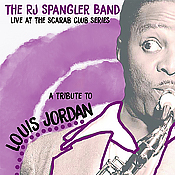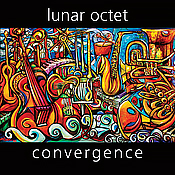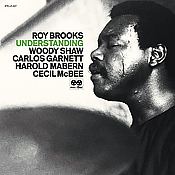Recent Recordings by Area Musicians

RJ Spangler and his friends, including trumpeter James O’Donnell, his old companion and co-leader of many of his bands, have been pressing their own Detroit brand on various moments of jazz history for decades, spanning a wide range from the Kansas City stylings of Bennie Moten to South African township sounds, and the Saturniana of Sun Ra. Their latest album is A Tribute to Louis Jordan (Eastlawn ELD 35), the third installment of the Live at the Scarab Club Series. The band, in addition to the leader on drums and background vocals, consists of his regulars: Dan Devins, vocals; Keith Kaminski, tenor sax; Goode Wyche III, baritone & alto saxes; James O’Donnell trumpet/background vocals; Tbone Paxton, trombone/vocals; Matt LoRusso, guitar; and Jeff Cuny, string bass.
Louis Jordan was a transitional figure who was one of the major creators of what was once labeled as Rhythm and Blues, an entertaining amalgam of jazz, urban blues, novelty tunes, often laced with humor that was once immensely popular and is often seen as a main precursor of Rock and Roll. Spangler and his cohort, here recorded during a performance at Detroit’s almost one hundred-year-old Arts and Crafts masterpiece Scarab Club. As a result, the atmosphere is jaunty and informal, in good keeping with the character of the music. Jordan’s big humorous hits are all here — “Saturday Night Fish Fry,” “Caledonia, or Let the Good Times Roll,” as well as more sedate numbers such as “Early in the Morning,” but while the spirit of the music is well conveyed here, these are no mere reenactments of past glories.
Jordan recorded these tunes for jukebox and radio play aimed at short playtime with tight arrangements, but this band swings them out, tipping the hat sometimes to the old arrangements, but mostly providing their own take, with plenty of room for swinging idiomatic solos. Vocalist Devins does a very nice job of channeling Jordan’s singing without coming too close to imitation; he is particularly effective on the old twenties post-crash anthem “Nobody Knows You When You Are Down and Out,” where the arrangement is sparser than in Jordan’s fifties version, and the singing more poignant and emotive. Significantly, the rhythm section is less aggressive most of the time but in a way more swinging, taking into account the passing of time.
Spangler clearly loves Jordan’s music and here he revisits it in his own manner, with both humor and dignity.

The Lunar Octet has been together off and on for three and a half decades and although they are well-known in our area, released only one recording twenty-five years ago. They are now back with Convergence (Summit 780), nicely recoded in a manner that showcases the complexity of their sound palate (Brandon Cooper—trumpet, flugelhorn, vocals, Stephen Hiltner–alto saxophone, clarinet, Paul VornHagen—tenor saxophone, soprano saxophone, alto clarinet, Sam Clark–guitar, Keaton Royer–piano, Jeff Dalton—acoustic bass, electric bass, vocals, Jon Krosnick—drums, Aron Kaufman—congas, bongos, vocals, Olman Piedra—timbales, Latin percussion). The Octet’s unique blend of African, Caribbean, South American rhythms wrapped in a modern jazz package is hard to resist and make it hard to stay still, as this is ultimately the finest type of dance music.
The tunes are originals by members of the band and the arrangements sometimes offer an illusion of a much bigger ensemble. Each composition uses different rhythms, exploiting to the full the three-member percussion section, driving the well-rehearsed horn section. All the soloists impress: it is particularly nice to hear trumpeter Cooper, so often encountered in section playing, have a chance to solo at length and VornHagen, in addition to his more often heard tenor and soprano sax artistry, provides a lovely outing on the rarely heard and often maligned alto clarinet on “Subway Tension,” sounding almost Middle Eastern in the way he focuses on the lower register of the horn. A quarter of a century is a long time, but it was worth the wait!

Among Detroit area expatriates, one who is a regular visitor home is saxophonist, composer, scholar, and educator Salim Washington, who now calls Durban, South Africa, where he teaches at the University of KwaZulu-Natal, his home. He appears on a new release by the cooperative group Alchemy Sound Project entitled Afrika Love (Artists Recording Collective ARC-?). In addition to Washington on tenor sax, flute, bass clarinet, and oboe, the ensemble consists of Samantha Boshnack, trumpet & flugelhorn; Erica Lindsay tenor sax, clarinet, alto flute; Michael Ventoso trombone; Sumi Tonooka piano; David Arend double bass; and Chad Taylor drums.
The main focus here is on compositions and arrangements by members of the collective, and although the music is played by a septet, it often sounds like a bigger orchestra, fully utilizing the wide palate of sounds offered by a rich array of instruments, including alto flute and oboe that are rarely heard in such contexts. There are many fine solos, although few are long, but the accent here is on arrangements and group interaction. Washington is featured often on his main horn, the tenor sax, but also provides wonderful moments on the bass clarinet, as on the atmospheric “The Cadillac of Mountains,” or on oboe on his own composition “Africa Love.” The composition is dedicated to South African pianist Africa Mkhize, who apparently discussed Zulu pitch patterns with him, leading to their application in this piece. The other musicians provide equally impressive statements throughout and the whole album is much enhanced by the inspired drumming of Chad Taylor, who while not a regular member of the collective, fits in perfectly.

A fourth item for this month’s listening is a major historical find, Understanding (Cellar Live RTRCD0007) by the great Detroit drummer, composer, and sometime musical saw player Roy Brooks, leading a quintet with Woody Shaw on trumpet, Carlos Garnett on tenor sax, pianist Harold Mabern and bassist Cecil McBee. Brooks was a drummer like no other, with a rhythmic drive all his own, something he shared with most Detroit jazz musicians. Even though he suffered from bipolar disease at a time when no effective medications were available, for most of his career he was able to triumph over such adversity and produced some magnificent music, whether with the Horace Silver Quintet when it was one of the most popular groups in jazz, with Yusef Lateef, with Max Roach, or with his own groups. The material on Understanding stems from a gig presented by Baltimore’s Left Bank Jazz Society on November 1, 1970; the same group presented him just a few months earlier and the recording of that performance was released in 1972 as The Free Slave on the Muse label, most likely his best-known release under his own name (nicely, the cover design of the new release mimics the style used by Muse). The latter also featured a quintet, although the pianist and saxophonist were different (Hugh Lawson and George Coleman), but it included Brooks’ composition “Understanding,” which was repeated at the second gig.
The double CD package offers two hours of highly intense music of a kind rarely captured in studio recordings, with long tunes from twenty to over thirty minutes each and extended solos by all members of the quintet. True to the period, much of it is modal in nature and there is a nice contrast between the concepts of the two front-line horn men. Garnett is quite on fire and his explorations, although naturally reflecting some of Coltrane’s contemporary approaches, are very much his own, with nice developments of ideas that create interesting flows. Shaw is very much at his best, full of ideas, his personal phrasing and use of harmony, particularly fourths, very much on exhibit here, and his approach to rhythm very much in sync with Brooks. Mabern and McBee are similarly on fire. This is definitely a group driven by the drummer: the leader is fully in control, pushing everyone with complex patterns and commentary, all enveloped in an incendiary propulsion that underlies all but does not overwhelm the music. The perfect way that Brooks begins Shaw’s “Zoltan” with a short solo, setting up the whole tune is instructive. At this point in his life, he was magical, with a seemingly limitless variety of technical resources, great focus, but also with a joy of playing that makes this music so exciting.
As with many “live” recordings, one has the sense that listening to the playback cannot rival the experience of being there in the moment. In this case, the music grows on you, more exciting with repeated listening. I would strongly recommend purchasing the CD rather than a download if nothing else for the well-illustrated booklet that includes wonderfully insightful liner notes by Mark Stryker and a very personal reminiscence of Brooks by his old friend Herb Boyd, as well as interviews with McBee, Garnett, Reggie Workman, and Louis Hayes. Notably, all proceeds from the sale of the album will go to the Detroit Sound Conservancy, a nonprofit dedicated to the preservation of the city’s musical heritage.